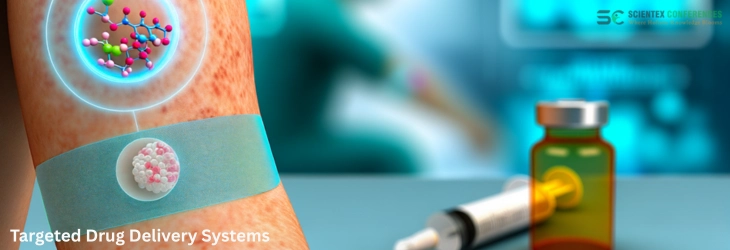Track: Targeted Drug Delivery Systems

The evolution of Targeted Drug Delivery Systems (TDDS) is transforming how dermatologic and cosmetic treatments are administered enhancing drug efficacy, reducing systemic side effects, and improving patient outcomes. This session focuses on cutting-edge approaches that allow for precise, localized, and controlled delivery of therapeutic agents directly to the affected skin layers or target cells.
Participants will explore innovations such as nanocarriers, liposomes, microneedles, hydrogels, polymer-based delivery systems, and smart drug delivery technologies that respond to specific stimuli (e.g., pH, temperature, enzymes). These advancements are particularly relevant in treating chronic skin diseases (e.g., psoriasis, acne, eczema), skin cancers, infections, and for aesthetic applications such as pigmentation correction and wrinkle reduction.
Fundamentals of Targeted Drug Delivery in Dermatology:
The skin, while serving as a critical protective barrier, presents significant challenges for transdermal drug delivery due to its highly selective permeability, particularly the stratum corneum. Overcoming this barrier is essential for effective localized treatment of dermatologic conditions. Localized drug release offers several advantages over systemic administration, including reduced systemic side effects, higher concentrations at the target site, and improved patient compliance. Understanding pharmacokinetics and pharmacodynamics in targeted delivery systems is key to optimizing therapeutic outcomes—ensuring that drugs are absorbed at the appropriate rate, reach effective concentrations in the skin layers, and exert their intended biological effects with precision and minimal toxicity.
Nanotechnology and Nano-carrier Systems:
Advanced nanocarrier systems such as liposomes, ethosomes, solid lipid nanoparticles (SLNs), and nanostructured lipid carriers (NLCs) are revolutionizing topical dermatologic therapies by enhancing drug stability, bioavailability, and targeted delivery. These carriers are engineered to improve penetration through the skin barrier, allowing for deeper and more controlled release of active ingredients. Case studies have demonstrated their efficacy in treating acne through targeted delivery of antibiotics and retinoids, in skin cancer therapy by enhancing localized chemotherapy or photodynamic agents, and in anti-aging applications through sustained release of antioxidants and peptides. Their high biocompatibility, customizable penetration depth, and capacity for controlled drug release make them valuable tools in modern dermatology, offering improved outcomes with reduced systemic exposure.
Microneedles and Transdermal Patches:
Microneedle technologies including dissolving, hollow, and hydrogel-forming variants are emerging as innovative, minimally invasive platforms for the painless transdermal delivery of therapeutic agents. These systems bypass the stratum corneum, enabling efficient delivery of drugs, vaccines, and cosmeceutical actives directly into the dermal layers. Their applications span from immunotherapy and vaccine administration to the targeted release of anti-aging or pigmentation-reducing compounds in cosmetic dermatology. Recent advances have also led to the development of smart patches that not only deliver drugs but also monitor physiological parameters in real time, offering personalized, responsive treatment. This integration of diagnostics and therapeutics positions microneedle systems as a promising frontier in both medical and aesthetic skin care.
Stimuli-Responsive and Smart Delivery Systems:
Stimuli-responsive drug delivery systems, which release therapeutic agents in response to specific triggers such as temperature, pH, UV light, or inflammatory markers, are redefining precision medicine in dermatology. These smart systems enable site-specific and condition-specific drug activation, minimizing systemic exposure and maximizing therapeutic efficacy. In skin cancers and flare-up conditions like psoriasis or eczema, these technologies allow for targeted chemotherapy or anti-inflammatory delivery precisely when and where needed. By tailoring release profiles to individual skin environments or disease activity, these approaches support highly personalized treatment regimens, offering improved outcomes, reduced side effects, and greater patient adherence.
Biopolymers and Hydrogels:
Injectable hydrogels have become a key innovation in wound healing and scar modulation due to their ability to provide a moist, biocompatible environment that supports cellular migration, angiogenesis, and tissue repair. These hydrogels, often derived from biodegradable polymer systems, are also integral to tissue regeneration and filler technologies in aesthetic medicine. By mimicking the extracellular matrix and enabling controlled degradation, they offer structural support while gradually releasing bioactive compounds or growth factors. In the realm of aesthetics, such systems are increasingly used in sustained-release products, allowing for prolonged effects with fewer interventions. This combination of regenerative support and precise drug delivery positions injectable hydrogels as a versatile and effective tool in both therapeutic and cosmetic dermatology.
Translational and Clinical Applications:
Transdermal drug delivery systems (TDDS) in dermatology must navigate stringent regulatory and safety considerations, including biocompatibility, controlled release performance, and potential for skin irritation or sensitization. Ensuring product consistency, appropriate dosing, and compliance with regulatory frameworks such as FDA or EMA guidelines is crucial for clinical adoption. Formulation challenges such as drug stability, penetration efficiency, and excipient compatibility must be addressed to optimize efficacy. Additionally, patient adherence can be influenced by ease of use, comfort, and visible results, making user-centric design essential. For successful integration into existing treatment protocols, TDDS should complement or enhance current therapies without introducing complexity, thereby improving both clinical outcomes and patient satisfaction.
Scientific Highlights
- Skin Diseases: Acne, Psoriasis, Dermatitis
- Cosmetic Surgery
- Dermatopathology
- Pediatric Dermatology
- Facelift (Rhytidectomy)
- Aesthetic Medicine
- Plastic Surgery
- Diet & Nutritional Supplements for Healthy Skin
- Oral and Maxillofacial Surgery
- Dermato oncology
- Dermatology
- Trichology and Hair Transplantation
- Vitiligo Treatment
- Rhinoplasty and Otoplasty
- Fungal Skin Infections
- Cosmetology
- Skincare Treatment
- Dermatologic Disorders
- Clinical Trial and Case Reports
- Teledermatology & AI Diagnostics
- Wound Care
- Leprosy in Modern Dermatology
- Onychomycosis
- Regenerative Aesthetics
- Targeted Drug Delivery Systems
- GI Health & Skin


